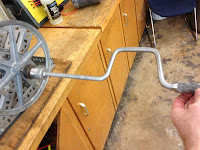It is possible to use a magnehelic gauge or a digital manometer
and two static pressure probes to determine the amount of airflow a blower is
moving. You can read the static pressure difference across the blower and
compare it to the manufacturer’s data to determine the blower CFM. It does make
a difference what type of blower you have and what type of motor the blower
uses. A typical residential blower uses a forward curved centrifugal blower and
a PSC motor. The airflow these blowers deliver decreases as the static pressure
the blower is working against increases. You need the manufacturer’s data to
compare the measured static pressure across the blower to the fan performance
table or curve. Here is a table from a unit with an air handler with a PSC
blower motor. Note that on high speed at a static pressure difference across
the unit of 0.1” wc the airflow is 1150 CFM, while at 0.7” wc across the unit
the airflow drops to 775 CFM.
|
PSC
Blower
|
External Static
|
||||||
|
Motor Speed
|
0.1” wc
|
0.2” wc
|
0.3” wc
|
0.4” wc
|
0.5” wc
|
0.6” wc
|
0.7” wc
|
|
High
|
1,150
|
1,095
|
1,045
|
1,025
|
950
|
865
|
775
|
|
Medium
|
890
|
855
|
835
|
775
|
715
|
665
|
605
|
|
Low
|
640
|
605
|
565
|
530
|
485
|
440
|
360
|
With ECM motors, the airflow varies very little as the
static pressure across the blower changes. That is the point of an ECM blower.
It recognizes the amount of static pressure it is working against and adjusts
the blower motor RPM and power output to keep the same programmed airflow – up to
a point. ECM motors do have a programmed speed limit. When they hit their speed
limit, they shut off. A key point here is that although the ECM motor can
compensate for extra restriction, it does this by using more electricity –
which can turn an energy efficient blower into an energy hog. It is far more
cost effective to remove the restriction than to pay for enough electricity to
shove the air through. At any rate, checking the static pressure across an ECM
blower is done primarily to make sure it is operating within its design
parameters and in an efficient manner. It does not tell you how much air the blower
is moving. A table from an air handler similar to the one above, but with an
ECM blower motor is listed below. Note that there is very little change in the
CFM as the static pressure across the blower increases. The CFM delivered is
determined by the program: A, B, C, D.
|
ECM
Blower
|
External Static
|
||||||
|
Motor Program
|
0.1” wc
|
0.2” wc
|
0.3” wc
|
0.4” wc
|
0.5” wc
|
0.6” wc
|
0.7” wc
|
|
A
|
630
|
625
|
625
|
620
|
610
|
605
|
600
|
|
B
|
895
|
885
|
875
|
865
|
845
|
825
|
815
|
|
C
|
1030
|
1020
|
1005
|
995
|
970
|
945
|
935
|
|
D
|
1185
|
1175
|
1160
|
1145
|
1120
|
1090
|
1080
|
X13 motors are also electronically commutated, but they are
programmed for a specific torque or power output, not a specific airflow. The
airflow across an X13 motor does drop off as the static pressure across it
increases, but not as dramatically as a PSC motor. They are considerably more
efficient than a PSC motor and considerably cheaper than a fully programmable
ECM. You can determine an airflow from the static pressure across the blower
and the manufacturer’s specifications. Below is data from an air handler with
an X13 blower motor. Note that its performance compared to external static pressure
is somewhere between a PSC motor and an
ECM blower.
|
X-13
Blower
|
External Static
|
||||||
|
Motor Program
|
0.1” wc
|
0.2” wc
|
0.3” wc
|
0.4” wc
|
0.5” wc
|
0.6” wc
|
0.7” wc
|
|
Tap 1
|
960
|
905
|
890
|
810
|
760
|
720
|
665
|
|
Tap 2
|
1,060
|
1,010
|
995
|
920
|
875
|
835
|
790
|
|
Tap 3
|
1,150
|
1,100
|
1,090
|
1,025
|
990
|
945
|
905
|
|
Tap 4
|
855
|
810
|
775
|
755
|
750
|
720
|
690
|
|
Tap 5
|
1,470
|
1,440
|
1,425
|
1,405
|
1,375
|
1,260
|
1,315
|






